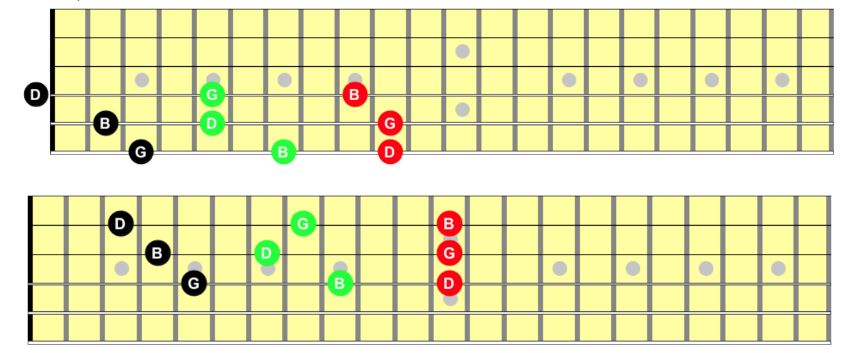Chord Triads For Electric Guitar – What They Are and Why They Are So Important!
Chord triads are the cornerstone of harmony in music, and for electric guitarists, they're the secret sauce to crafting captivating leads, funky rhythm parts, and dynamic chord progressions.
By unlocking the power of triads, you'll be able to connect the entire fretboard and transform your playing from basic chords to a world of expressive possibilities.
Let's dive into the world of chord triads below. And if you want to learn more about lead guitar playing, check out my free Lead Guitar Crash Course by clicking the on the image.
Find this website helpful? Click the button to show your support.
Demystifying Chord Triads:
A triad is a three-note chord built on specific intervals. If we take the major scale, it's built on a combination of 7 notes separated by a specific formula of spaces between the notes or INTERVALS.
We give these 7 notes a numerical identifier that corresponds to the order the note occurs in the scale – the 1, the 2, the 3 etc. The foundation for triads is the 1 or what we also call the root note, which gives the chord its name (C major triad, G minor triad, etc.).
Triads are made by putting together notes a “third” interval apart, which are nothing more than every other note in a scale. Notes a “major third” apart are separated by 4 frets on the fretboard, and notes a “minor third” apart are separated by 3 frets.
Stacking a major or minor third on top of the root creates the defining characteristic of the triad – the "brightness" or “happiness” of a major or the "darkness" or “sadness” of a minor. Finally, a perfect fifth (the 5th note we come to after starting at the root or 1) competes the triad, adding fullness and stability.
The Magic of Moveable Shapes:
Learning triads isn't about memorizing endless finger positions. The beauty lies in mastering a few "moveable shapes" that you can shift around the fretboard. There are two primary ways to think about moving the shapes around the fretboard:
- Vertically across the guitar neck.
- Horizontally up and down the guitar neck.
Let me give you some examples of both!!!
In the following diagrams we'll look at major triad shapes, starting on the same FRET each time but different strings:

- In the first diagram we see the shape for an A Major triad, made up of the notes A C# and E, or the 1st, 3rd and 5th notes of the A Major scale.
- In the 2nd diagram, we see the same SHAPE but now with D as the starting note which results in a D Major triad.
- In the 3rd diagram, we have a G major triad starting on the D string. The shape changes slightly because of the tuning of the B string.
- Lastly we have a C Major Triad starting on the G string. Again the shape is different from the first 3 diagrams because of the tuning of the B string.
Let's turn those same 4 triads from major to minor by “flattening” the 3rd interval of each one and making it a “minor” third instead of a “major” third. This results in a triad that sounds sad! Compare each of these minor triads with their major counterpart in the previous diagram!!!

• In the first diagram we have an A minor triad made up of the notes A-C-E
• In the 2nd diagram we have a D minor triad made up of the notes D-F-A
• The third diagram is a G minor triad with the notes G-Bb-D
• The last diagram is a C minor triad with the notes C-Eb-G
Another way to think about triads on the guitar neck is to find a particular root note (in the following example we'll use G) and put together a triad shape everywhere on the fretboard for that note! Consider the following diagram:

• We have a G major triad starting with the G on the 3rd fret of the low E (Black)
• There's a G major triad starting with the G at the 10th fret of the A string (Red)
• Another G major triad starts with the G at the 5th fret of the D string (Green)
• We can play a G major triad from the G at the 12th fret of the G string (Light blue)
• There's a G at the 8th fret of the B string and a G major triad (Pink)
Here are the G minor triad shapes that correspond with the major shapes above:

Here are some strategies for Building Your Triad Toolbox:
1. Major Triads: Start by learning the major triad shapes on the E and A strings. Practice switching between them, focusing on clean technique and clear note separation. Once comfortable, move these shapes to other string sets like D and G.
2. Minor Triads: Master the minor triad shapes using the same approach. Pay attention to the slightly different finger placement compared to major triads.
Beyond the Basics: Chord Triad Inversions:
Don't just play triads with the root note on the bottom. Each major or minor triad has 2 of what we call “inversions” - which is just a fancy way of saying start on a note OTHER than the root. So, we can start on the 3rd and play 3-5-1 or start on the 5th and play 5-1-3. Each inversion has a slightly different sound, and will allow you to move to different places on the fretboard.
The following fretboard diagrams illustrate how we can move up and down the fretboard with these different inversions. We'll again use the key of G, and the notes G, B and D to create the different inversions of a G major triad. The root forms are in Black, the 1st inversions are in Green, and the 2nd inversions are in Red.

Fueling Your Triad Journey:
Because I believe so heartily in the concept of triads as the basis for your rhythm AND lead playing, I've made multiple YouTube videos on the subject. Here are some links to these excellent resources:
https://youtu.be/rkMsgNaeddc?si=cyWs1ca5Tm5FnbcV
https://youtu.be/F1Z_alP9gG8?si=wNCyZp1UMfPJs5v8
https://youtu.be/ChiBBJLdr-s?si=PQ-27FaM5n2sANtl
This should be more than enough to get you well versed and ready to make music with triads!
So grab your axe, dive into the world of triads, and unleash your sonic potential!
